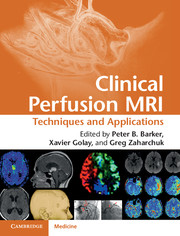Book contents
- Frontmatter
- Contents
- List of Contributors
- Foreword
- Preface
- List of Abbreviations
- Section 1 Techniques
- Section 2 Clinical applications
- 8 MR perfusion imaging in neurovascular disease
- 9 MR perfusion imaging in neurodegenerative disease
- 10 MR perfusion imaging in clinical neuroradiology
- 11 MR perfusion imaging in oncology: neuro applications
- 12 MR perfusion imaging in oncology: applications outside the brain
- 13 MR perfusion imaging in breast cancer
- 14 MR perfusion imaging in the body: kidney, liver, and lung
- 15 MR perfusion imaging in cardiac diseases
- 16 MR perfusion imaging in pediatrics
- Index
- References
13 - MR perfusion imaging in breast cancer
from Section 2 - Clinical applications
Published online by Cambridge University Press: 05 May 2013
- Frontmatter
- Contents
- List of Contributors
- Foreword
- Preface
- List of Abbreviations
- Section 1 Techniques
- Section 2 Clinical applications
- 8 MR perfusion imaging in neurovascular disease
- 9 MR perfusion imaging in neurodegenerative disease
- 10 MR perfusion imaging in clinical neuroradiology
- 11 MR perfusion imaging in oncology: neuro applications
- 12 MR perfusion imaging in oncology: applications outside the brain
- 13 MR perfusion imaging in breast cancer
- 14 MR perfusion imaging in the body: kidney, liver, and lung
- 15 MR perfusion imaging in cardiac diseases
- 16 MR perfusion imaging in pediatrics
- Index
- References
Summary
Introduction
Breast cancer is the most common cancer diagnosed in women in the United States, with about 200 000 new cases diagnosed in the USA in 2010, and it is the second most common cause of death among females, after lung cancer [1]. Pathophysiology of breast cancer is related to vascular and perfusion anomalies. Living cells require oxygen and nutrients to survive; for that reason they need to develop new blood vessels, since the largest distance compatible with simple oxygen diffusion is 200 µm. When small malignant lesions develop in the breast, they can satisfy oxygen and nutrient demands through simple diffusion; however, as malignant tumors enlarge, they are no longer capable of relying on diffusion. Demands for oxygen and nutrients exceed supply, leading to an ischemic and hypoglycemic state (metabolic stressors). These metabolic stressors along with many other identified stressors, such as mechanical (pressure generated by proliferating cells in the tumor space), immune/inflammatory cells, or genetic mutations (activation of oncogenes or deletion of suppressor genes), stimulate the release of many biochemical factors, among which is the vascular endothelial growth factor (VEGF). VEGF promotes the formation of new branching and feeding vessels from pre-existing peritumoral capillaries [2]. Circulating endothelial cells that were shed from the vascular wall and bone marrow may contribute to the angiogenesis as well [3, 4].
- Type
- Chapter
- Information
- Clinical Perfusion MRITechniques and Applications, pp. 255 - 280Publisher: Cambridge University PressPrint publication year: 2013



